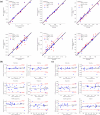Assessment of temporospatial and kinematic gait parameters using human pose estimation in patients with Parkinson's disease: A comparison between near-frontal and lateral views
- PMID: 39854295
- PMCID: PMC11760030
- DOI: 10.1371/journal.pone.0317933
Assessment of temporospatial and kinematic gait parameters using human pose estimation in patients with Parkinson's disease: A comparison between near-frontal and lateral views
Abstract
Gait disturbance is one of the most common symptoms in patients with Parkinson's disease (PD) that is closely associated with poor clinical outcomes. Recently, video-based human pose estimation (HPE) technology has attracted attention as a cheaper and simpler method for performing gait analysis than marker-based 3D motion capture systems. However, it remains unclear whether video-based HPE is a feasible method for measuring temporospatial and kinematic gait parameters in patients with PD and how this function varies with camera position. In this study, treadmill and overground walking in 24 patients with early PD was measured using a motion capture system and two smartphone cameras placed on the near-frontal and lateral sides of the subjects. We compared the differences in temporospatial gait parameters and kinematic characteristics between joint position data obtained from the 3D motion capture system and the markerless HPE. Our results confirm the feasibility of analyzing gait in patients with PD using HPE. Although the near-frontal view, where the heel and toe are clearly visible, is effective for estimating temporal gait parameters, the lateral view is particularly well-suited for assessing spatial gait parameters and joint angles. However, in clinical settings where lateral recordings are not feasible, near-frontal view recordings can still serve as a practical alternative to motion capture systems.
Copyright: © 2025 Kim et al. This is an open access article distributed under the terms of the Creative Commons Attribution License, which permits unrestricted use, distribution, and reproduction in any medium, provided the original author and source are credited.
Conflict of interest statement
The authors have declared that no competing interests exist.
Figures





References
Publication types
MeSH terms
LinkOut - more resources
Full Text Sources
Medical

